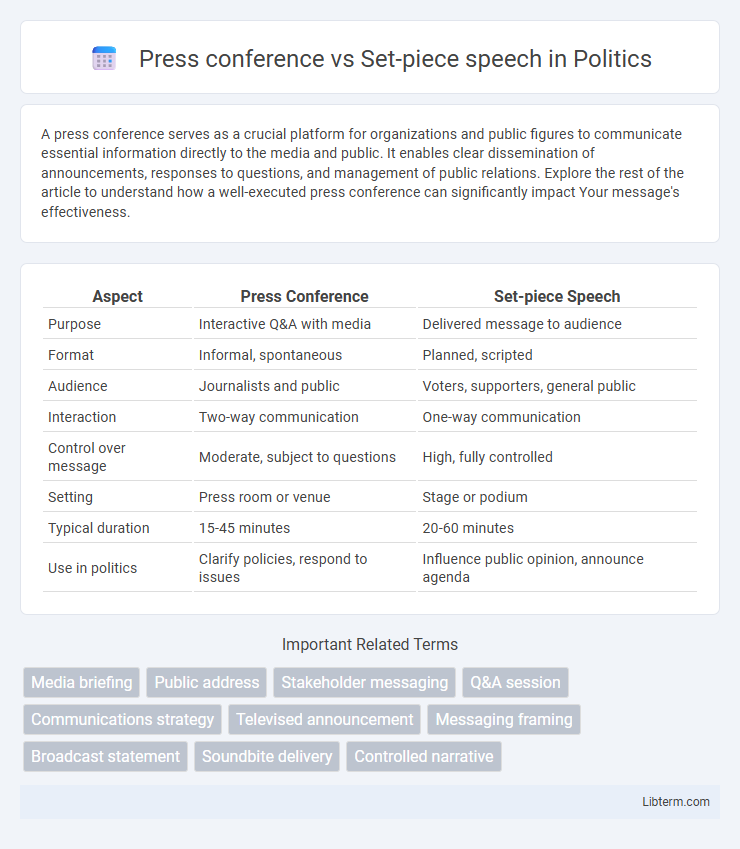A press conference serves as a crucial platform for organizations and public figures to communicate essential information directly to the media and public. It enables clear dissemination of announcements, responses to questions, and management of public relations. Explore the rest of the article to understand how a well-executed press conference can significantly impact Your message's effectiveness.
Table of Comparison
| Aspect | Press Conference | Set-piece Speech |
|---|---|---|
| Purpose | Interactive Q&A with media | Delivered message to audience |
| Format | Informal, spontaneous | Planned, scripted |
| Audience | Journalists and public | Voters, supporters, general public |
| Interaction | Two-way communication | One-way communication |
| Control over message | Moderate, subject to questions | High, fully controlled |
| Setting | Press room or venue | Stage or podium |
| Typical duration | 15-45 minutes | 20-60 minutes |
| Use in politics | Clarify policies, respond to issues | Influence public opinion, announce agenda |
Understanding Press Conferences: Definition and Purpose
Press conferences are organized events where journalists ask questions to public figures or organizations, aiming to clarify information and provide transparency. They facilitate direct communication between the media and speakers, allowing real-time interaction and spontaneous responses. Unlike set-piece speeches, press conferences prioritize dialogue and responsiveness over scripted messaging.
Set-piece Speeches: What Sets Them Apart
Set-piece speeches are meticulously crafted and rehearsed presentations designed to deliver a clear, impactful message on specific occasions, often reflecting a leader's vision or policy stance. Unlike press conferences that prioritize spontaneity and interaction with the media, set-piece speeches emphasize polished rhetoric and structured content to influence public opinion or reaffirm authority. The deliberate use of persuasive language, memorable phrases, and thematic coherence distinguishes set-piece speeches as strategic communication tools in political and corporate environments.
Key Objectives: Press Conference vs Set-piece Speech
Press conferences aim to facilitate transparent interaction between speakers and the media, allowing for spontaneous questions that reveal real-time information and clarify positions on current issues. Set-piece speeches focus on delivering carefully crafted, strategic messages to influence public opinion or articulate policy goals, emphasizing control over content and tone. The key objective of a press conference is engagement and information exchange, while a set-piece speech prioritizes persuasion and message consistency.
Audience Engagement: Real-time Interaction vs Scripted Delivery
Press conferences enable real-time interaction by allowing journalists to ask questions, fostering dynamic audience engagement and spontaneous dialogue. Set-piece speeches involve scripted delivery with limited audience participation, emphasizing a controlled and polished presentation of key messages. The immediacy of press conferences contrasts with the structured format of set-piece speeches, shaping differing audience experiences and responsiveness.
Media Control: Structure and Message Management
Press conferences involve dynamic interaction between speakers and journalists, allowing real-time questions that test message control, whereas set-piece speeches offer tightly scripted content with minimal deviation, enhancing structured message delivery. Media control in press conferences requires strategic handling of unpredictable queries to maintain narrative coherence, while set-piece speeches rely on premeditated rhetoric and rehearsed emphasis to dominate media framing. Effective media management hinges on balancing responsiveness in press conferences with the precision and consistency inherent in set-piece speeches.
Public Perception: Transparency vs Authority
Press conferences foster public perception of transparency by enabling real-time interaction, spontaneous questioning, and direct responses from officials, which builds trust and openness. Set-piece speeches project authority through carefully crafted messages and controlled delivery, emphasizing leadership and command over precise information flow. While press conferences emphasize accountability and candid communication, set-piece speeches reinforce credibility and influence by showcasing polished, authoritative narratives.
Preparation Process: Spontaneity vs Pre-planning
Press conferences require a balance of preparedness and spontaneity, where speakers anticipate a range of questions but must adapt responses in real-time to maintain authenticity. Set-piece speeches involve extensive pre-planning, with meticulously crafted messages and rehearsed delivery to ensure precise communication of key points. The preparation process for set-piece speeches prioritizes control over content and timing, contrasting with the dynamic, reactive nature of press conference interactions.
Risks and Challenges in Each Format
Press conferences pose risks such as loss of message control due to unscripted questions and potential hostile inquiries that can derail the intended narrative. Set-piece speeches face challenges including limited audience interaction, which may reduce engagement and adaptability to public sentiment. Both formats require strategic preparation to mitigate miscommunication and preserve the speaker's credibility under scrutiny.
Choosing the Right Format for Effective Communication
Selecting between a press conference and a set-piece speech depends on the desired communication outcome and audience engagement level. Press conferences facilitate interactive dialogue, allowing real-time questions and clarifications, ideal for dynamic information sharing and crisis management. Set-piece speeches provide controlled, polished messaging suited for delivering key points with authority during formal events or product launches, ensuring consistent communication without interruption.
Future Trends in Public Address and Media Engagement
Press conferences are evolving with the integration of real-time digital interaction tools, enabling immediate audience feedback and expanded media participation through virtual platforms. Set-piece speeches increasingly incorporate multimedia elements and interactive segments to enhance engagement and convey complex messages effectively in a multi-channel environment. Future trends emphasize a hybrid model combining the spontaneity of press conferences with the structured delivery of set-piece speeches to optimize public address impact and media engagement.
Press conference Infographic

 libterm.com
libterm.com